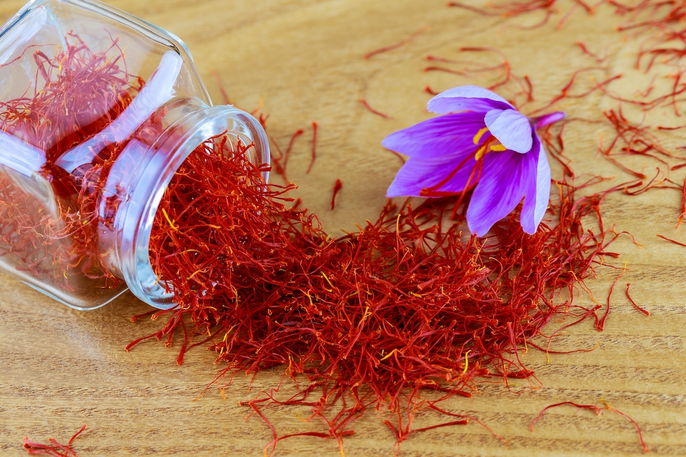Saffron is a medicinal plant that contains many therapeutic properties which are most concentrated in the flower’s filament. It is rich in crocin, crocetin, safranal and kaempferol, and contains anti-inflammatory and antioxidant properties.
Saffron is beneficial to relieve symptoms of PMS, to help with weight loss and to prevent cardiovascular disease.
Saffron can be purchased in natural health stores, compound pharmacies, or open markets. It is often utilized as a spice in cooking, and can also be consumed as tea. Its tea-form should only be ingested under the supervision of a doctor or medicinal plant specialist, especially if you are trying to obtain health benefits from it.

Health Benefits
Studies on saffron have shown that this plant contains various medicinal properties. It can be used for:
1. Treating depression
Some studies [1,2] have shown that the crocin and safranal present in saffron have a anti-depressant-like action that is is similar to fluoxetine and imipramine. These substances help to prevent the reuptake of dopamine and noradrenaline, which are neurotransmitters that help to regulate mood. Saffron can be used as a complement to the medical treatment of depression, anxiety and other mood disorders.
2. Managing diabetes
Saffron possess antioxidant and anti-inflammatory properties that protect the pancreatic cells and improve insulin production. This helps to regulate blood sugar levels and help control diabetes.
3. Promoting weight loss
Some studies [3,4] show that saffron can help with weight loss, as it boosts mood and reduces appetite, leading to less overall daily intake of calories.
In addition, another study showed that saffron supplementation [4] can help to reduce BMI, waist circumference and body fat composition.
4. Relieving symptoms of PMS
Due to its anti-inflammatory, antioxidant and antidepressant properties, saffron can help to relieve the more common symptoms of PMS, like irritability, anxiety, headache, bloating and cravings.
5. Complementing Alzheimer’s treatment
Saffron possesses antioxidant properties that help to reduce the damage free radicals cause on neurons. It also increases acetylcholine levels, which is a neurotransmitter that is important for memory and tends to decrease with the progression of Alzheimer’s disease.
Saffron also contains anti-inflammatory properties that reduce the production of substances that are inflammatory and toxic to the neurons. However, more studies on this effect are required to support this benefit.
6. Preventing Parkinson’s disease
Studies completes on cells and rats have shown that the antioxidant and anti-inflammatory effect of crocetin found in saffron helps to protect the neurons. This may help to prevent and even help to treat Parkin’s disease, as it improves the lack of motor coordination associated with this disease. However, more studies on humans are needed to support this benefit.
7. Preventing cardiovascular disease
Crocin that is present in saffron has a potent antioxidant action, which can help to reduce bad cholesterol levels. This types of cholesterol attaches to the lining of the arteries to form fatty plaques over time. In reducing levels, saffron can help to reduce the risk for cardiovascular diseases like atherosclerosis, heart attack or a stroke.
8. Improving sexual health
Saffron contains aphrodisiac properties that help to boost wellbeing, sexual urges and libido, particularly in people who use antidepressants. It can improve erectile dysfunction as well as improve natural lubricant production in women.
9. Complementing cancer treatment
Some studies [5,7] completed on cancer cells (specifically cancerous skin, intestine, breast, cervical, prostate and lung cells), show that antioxidant substances that are present in saffron help to decrease the proliferation or increase elimination of these types of cancer.
In addition, saffron may make cancerous cells more sensitive to chemotherapy treatment. However, moer studies in humans are needed to support this benefit.
How to take it
Saffron can be found as a spice and is often used in the kitchen, particularly to add flavor to meat and sauces.
It can also be used as a home remedy when made as a tea.
1. Saffron tea
Saffron tea should be prepared with the red filaments present in the center of the flower. This is where the medicinal substances are most found.
Ingredients
- 1 teaspoon of saffron filaments
- 500 mL (about 17 oz) of boiling water
How to prepare
Add the filaments to the boiling water. Cover and allow to soak for 5 to 10 minutes. Then strain, allow to cool and drink one cup of saffron tea, once per day.
Because saffron tea has a mildly bitter taste, you can add other ingredients to make it more enjoyable to drink, like cinnamon, ginger or honey.
2. Saffron capsules
You can also ingest saffron in capsule form. The general recommended dose is 20 to 100 mg per day, for up to 3 months, as guided by a doctor.
Possible side effects
Saffron is safe for temporary use in small quantities in most adults. However, if large doses are taken (over 100 mg), or if it is used for long periods (over 26 weeks) it may cause side effects like drowsiness, delirium, vertigo or gastrointestinal symptoms like nausea, vomiting and diarrhea.
It is possible to overdose on saffron, when consumed in doses over 5 g, which can be life-threatening.
Contraindications for use
Saffron should not be used by pregnant or breastfeeding women. Saffron may promote uterine contraction in pregnant women, which can increase the risk for a miscarriage or hemorrhage.
Saffron should also not be used in people with a history of bipolar disorder, nor by those with allergies to saffron, olives or to plants from the Lolium, Salsola or Olea species.






























